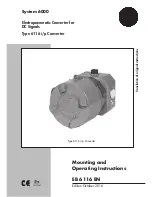
POWER ELECTRONICS
SD750FR
POWER CONNECTION
49
Low Voltage Ride Through (LVRT)
The Low Voltage Ride Through (LVRT) protection is very useful for applications that control a
continuous process and cannot afford to stop because of short voltage outages or dips coming from
the grid. The process must continue to run through these outages, typically 2 to 3 cycles.
Voltage dips cause a decrease of the DC Bus voltage in the drive. During very brief dips, it may be
possible to supply the energy from the DC Bus capacitors. However, during longer dip periods, the DC
Bus voltage will drop to a lower level and if this falls below the DC Bus trip voltage, the drive will trip in
the default configuration.
A voltage dip could usually be a risky situation for any kind of equipment and / or circuit protection
devices connected to the grid when it is cleared. At this moment, as full AC voltage is connected, some
devices, including VFD’s, can demand a high current causing high voltages and current transients.
SD750FR drives are by default in compliance with IEC/EN 61800-3 product standard
“Adjustable speed
electrical power drive systems -
Part 3: EMC requirements and specific test methods”. Dip test levels
are defined in IEC 61000-4-34
“Voltage dips, short interruptions and voltage variations immunity tests
for equipment”. During a voltage dip, drives are allowed, by criterion C of IEC/EN 61800-3, to trip. A
manual restart could even be required. They are neither allowed to be damaged nor misconfigured.
Furthermore, SD750FR drives with software version AFE_R1.4.0 or higher, include a new algorithm
that overperforms the requirements of the standard by making them comply with the criterion A or B of
the IEC/EN 61800-3, for the tests as defined in IEC 61000-4-34, regardless of the voltage dip depth
and duration, and capable to restart them automatically without affecting its operational safety during
a voltage dip. Depending on the voltage dip depth and duration, the
drive’s two possible behaviours
are as follows:
•
When voltage dips are up to 70%, the drive remains connected, regulating the DC voltage
and keeping the
motor’s performance at any moment.
•
When voltage dips are higher than 70%, the drive remains connected using the rectifier bridge
in “diodes” mode (no IGBT switching) and the DC Bus voltage varies depending on the input
voltage level. In this case, the motor can increase its input current, and vary its torque and
speed response depending on its operation conditions. When the input voltage is back to
nominal conditions, the rectifier bridge restarts automatically and the intended torque and
motor speed levels are recovered immediately.
Test results can demonstrate that SD750FR new LVRT algorithm improves the requirements of the
standard, not only on performance criteria achieved, but also in dips severity, as shown in the next
figure:
Содержание SD750FR
Страница 1: ...SD750FR HARDWARE AND INSTALLATION MANUAL 4Q REGENERATIVE ACTIVE FRONT END DRIVE...
Страница 2: ......
Страница 54: ...SD750FR POWER ELECTRONICS 52 POWER CONNECTION EN Connections for frame 6...
Страница 55: ...POWER ELECTRONICS SD750FR POWER CONNECTION 53 Connections for frame 7...
Страница 56: ...SD750FR POWER ELECTRONICS 54 POWER CONNECTION EN Connections for frame 8...
Страница 79: ......
Страница 80: ...24H TECHNICAL ASSISTANCE 365 DAYS A YEAR FIND YOUR NEAREST DELEGATION POWER ELECTRONICS COM CONTACT...
















































